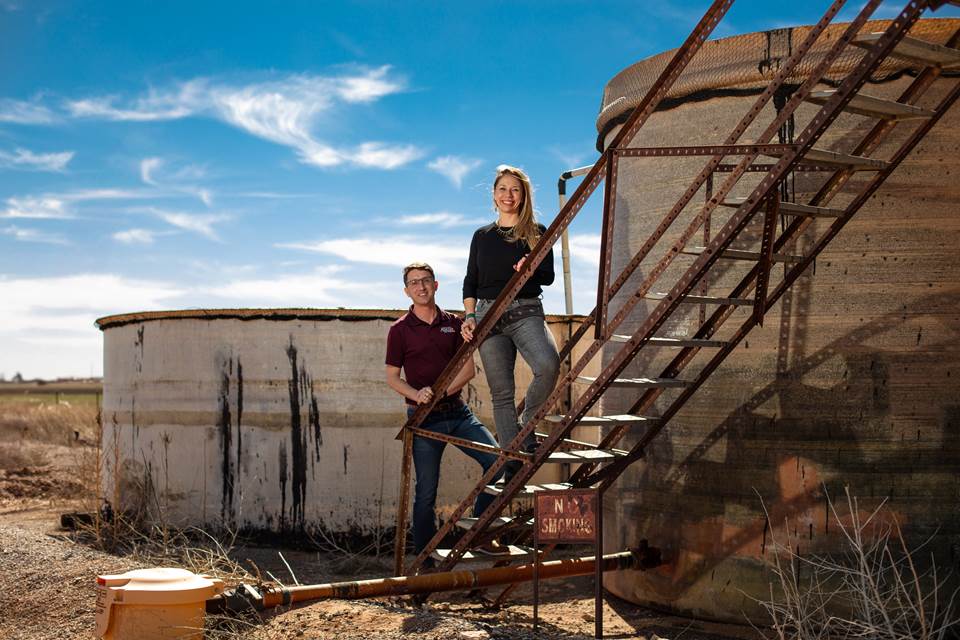Estimated reading time: 5 minutes
Texas A&M AgriLife Research scientists study the impacts of using treated water produced by oil and gas operations for irrigating non-consumptive crops
More Information
- Lewis and Burke Labs: Soil Chemistry and Fertility
- Texas Supreme Court: Produced Water Conveys to Mineral Lessee – Texas Ag Law Blog, Texas A&M AgriLie Extension
Want to get txH20 delivered right to your inbox? Click to subscribe.
There is one type of water currently in abundance in West Texas and Far West Texas: produced water resulting from the oil and gas industry.
Texas annually generates up to 500,000 acre-feet of treated produced water, experts say.
Market factors and governmental policies make it likely that produced water will be available in the region for some time. Still, more research is needed around a key question: Could this water be safely used for beneficial purposes instead of being pumped back below ground in injection wells?
Limited water resources
In semi-arid West Texas, regional agricultural production has decreased over the last two decades due to limited water quantity and quality, said Katie Lewis, Ph.D., Texas A&M AgriLife associate professor of soil fertility and chemistry in Lubbock.
Could reusing produced water that’s been treated help local agricultural economies survive?
Step one of answering these questions is, can the water be successfully treated and cleared of all industrial chemical levels that could be harmful to ecosystems or humans?
As a byproduct of oil and gas extraction, produced water is high in organic materials, salt, and minerals, making it unsuitable for consumption. Companies currently use treatment processes to filter the water to remove any additional hydrocarbons before reinjecting it into the ground.
Texas A&M Engineering experts are researching the best methods for successfully cleaning the water to a standard suitable for agricultural use; see page 9.
Step two is, if that water can be successfully treated, could it then be used to irrigate nonconsumptive crops, such as cotton and forage grains?
And, how will that irrigation application affect the surrounding soil, air and water?
Texas A&M AgriLife Research is conducting multiscale research projects to answer this, Lewis said.
“We’re evaluating annual and perennial cropping systems irrigated with treated produced water, and a research site has been established in the Trans-Pecos Region to observe these effects,” she said.
AgriLife researchers start investigating
A few years ago, Lewis and collaborator Joseph Burke, Ph.D., AgriLife Research and Extension Service assistant professor of cropping systems agronomy, jumped feet-first into answering these questions.
When a research opportunity sponsored by Anadarko and Energy Water Solutions became available, Lewis’ lab began studying land applications of treated produced water to fields using drip irrigation.
“My research group jumped all in,” she said.

They collaborated with state and federal agencies to ensure that the water complied with regulations and then began field research.
Their results showed that irrigating with treated produced water blended with groundwater did not reduce cotton yield or lint quality, but did reduce soil salinity, she said.
In another study, the research team focused on the soil’s reactions to produced water.
“We monitored the chemical, physical and biological aspects of the soil that are being influenced potentially by the produced water,” Lewis said. “Three different irrigation waters were used: traditional groundwater, simulated produced water that we created in our lab, and clean produced water filtered by Texas A&M University’s Dr. Shankar Chellam.”
This study was funded by Solaris Water. Lewis and Burkes’ team found that produced water had minimal detrimental effects on plant development and mineral uptake, and it enhanced soil carbon, pH, and micronutrient availability.

New frontiers
Lewis and Burke are now studying additional treatment strategies for produced water and the long-term effects on soil and plant productivity, in research funded by WaterBridge Operating, LLC.
“This study will begin with the produced water getting treated in a novel three-step process by one of the water industry partners in the study — using absorption, regeneration and membranes,” Burke said. “And then our portion of the research will be studying if forages and row crops can potentially thrive with produced water.”
The team will monitor the impact of produced water on soil parameters, water quality, plant growth, and greenhouse gas emissions. “We'll do a complete ecological assessment of these crops,” he said.
In another study, sponsored by the U.S. Department of Energy, Lewis and Burke are partnering with ARIS Water and New Mexico State University to analyze the feasibility of cost-effective beneficial reuse of treated produced water.
They are studying crop irrigation with treated produced water, growing non-consumptive crops: cotton, bioenergy sorghum and bioenergy peanuts. New Mexico State is leading the engineering and water filtration portion of the project, and Lewis and Burke are leading the agricultural work.
“This will be the largest-scale pilot study of produced water applications we’ve been a part of so far,” Burke said.
The project will be growing forage, for hay production, and forage breeders and agronomists are also collaborators in the effort.
“These forages are going to be able to accumulate and withstand the high salinity that this water will add to the soil, but then we're going to cut and bale it, and so it will be removed off the field, hopefully maintaining and improving soil quality, because we are removing those salts,” Lewis explained.
Cotton harvest. Photo by Courtney Sacco, Texas A&M AgriLife.
Revitalizing agricultural industries
The Trans-Pecos region once produced renowned crops, including Pecos cantaloupe and watermelon, Burke said, and he and his colleagues are curious to see if treated produced water could help revitalize those farming communities.
“Could this water source bring some agricultural production back to the region, specifically growing nonconsumptive crops right now, like cotton, bioenergy peanuts or sorghum?” he said. Growing edible crops with cleaned produced water is a far-off question, Lewis said, but nonconsumptive crops are a near-future possibility.
“Both Joseph and I are highly devoted to agricultural production not just in the High Plains, but across the state, both professionally and personally,” Lewis said.
“And we know that inevitably, and I would say even currently, but inevitably, water is going to be the reason that agricultural production declines in areas like the High Plains and West Texas, regions that are dependent on groundwater resources or surface water resources. And so, if we can have an alternative source to continue to grow our crops, we're going to better sustain the level of productivity that we're at now.”
Explore this Issue
Authors
As communications manager, Leslie Lee leads TWRI's communications and marketing strategy and team, manages TWRI's publications, and coordinates effective communications support for TWRI's numerous projects serving the state of Texas.












